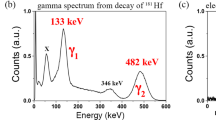Abstract
We report a comparison of electric-field gradients (EFGs) measured at the group-III sites on epitaxially-grown surfaces of 2×2-reconstructed GaAs and InAs crystals. For this purpose, we used 111In→111Cd perturbed-angular-correlation (PAC) spectroscopy. Sharp spectral lines characterize the perturbation functions corresponding to both surfaces. On GaAs surface, we observe only one well-defined nuclear electric-quadrupole interaction (NQI); and on the InAs surface, we observe a primary and a secondary NQI. Very similar but experimentally-distinguishable values of the EFG-parameters characterize the primary interactions corresponding to the GaAs and InAs surfaces. Specifically, for the GaAs and InAs surfaces, ω Q =28.0±0.2 Mrad s−1 and η=0.43±0.02 and ω Q =28.8±0.2 Mrad s−1 and η=0.39±0.02, and the angles between EFG z-axis and the (111) direction are 65°±3° and β=53°±3°, respectively. These unexpected results indicate that the so-called lattice contribution to the EFG is not significant. Moreover, for the primary NQIs on both surfaces, the similar parameter values demonstrate that chemical differences between the 111In probe and the indigenous Ga surface atoms cause no large quantitative effects. This information indicates that impurity probes and PAC spectroscopy can be used effectively to investigate III–V surfaces.
Similar content being viewed by others
References
For a description of the PAC technique, see: Catchen, G. L., Mater. Research Soc. Bull. 20 (1995), 37.
Adams, J. M., Catchen, G. L., Loubychev, D., Fu, J. and Miller, D. L., Nucl. Instr. Meth. Phys. Res. B 143 (1998), 591.
Adams, J. M., Catchen, G. L., Fu, J. and Miller, D. L., Surface Sci. 337 (1995), 118.
Catchen, G. L., Adams, J. M., Fu, J. and Miller, D. L., Hyp. Interact. 97-98 (1996), 193.
Adams, J. M., Ph.D. Dissertation, The Pennsylvania State University, 1995.
Adams, J. M., Fu, J., Catchen, G. L. and Miller, D. L., Appl. Phys. Lett. 61 (1992), 2668.
Lindgren, B., Hyp. Interact. C 1 (1996), 613.
Biegelsen, D. K., Bringans, R. D., Northrup, J. E. and Swarz, L.-E., Phys. Rev. Lett. 65 (1990), 452.
Setzer, C., Platen, J., Bludau, H., Gierer, M., Over, H. and Jakobi, K., Surface Sci. 402-404 (1998), 782.
Ren, H.-W., Tanaka, M. and Nishinaga, T., Appl. Phys. Lett. 69 (1996), 565.
Avery, A. R., Tok, E. S. and Jones, T. S., Surface Sci. 376 (1997), L397.
Thornton, J. M. C., Woolf, D. A. and Weightman, P., Appl. Surface Sci. 123-124 (1998), 115.
For a thorough discussion of probe chemistry, see: Wichert, Th., Achtziger, N., Metzner, H. and Sielemann, R., Perturbed angular correlation, In: G. Langouche (ed.) Hyperfine Interaction of Defects in Semiconductors, Elsevier, Amsterdam, 1992.
Author information
Authors and Affiliations
Rights and permissions
About this article
Cite this article
Catchen, G.L., Loubychev, D. & Platzer, R. Electric-Field Gradients at Group-III Sites on GaAs and InAs (111)B Surfaces. Hyperfine Interactions 136, 633–639 (2001). https://doi.org/10.1023/A:1020586808228
Issue Date:
DOI: https://doi.org/10.1023/A:1020586808228




